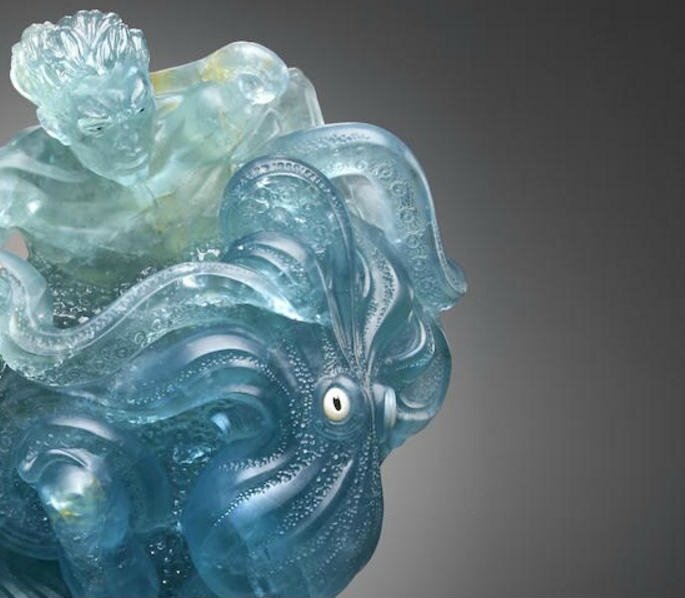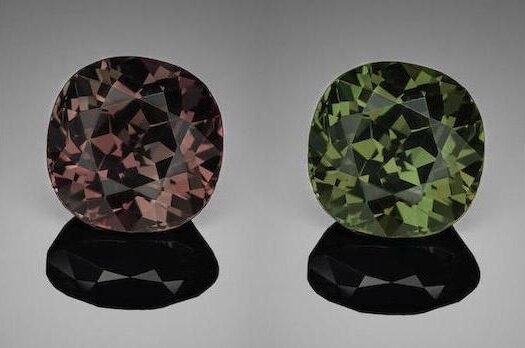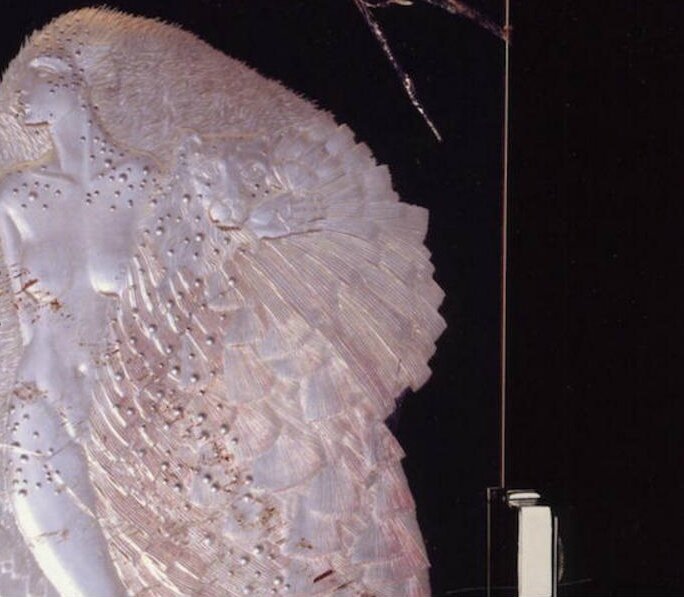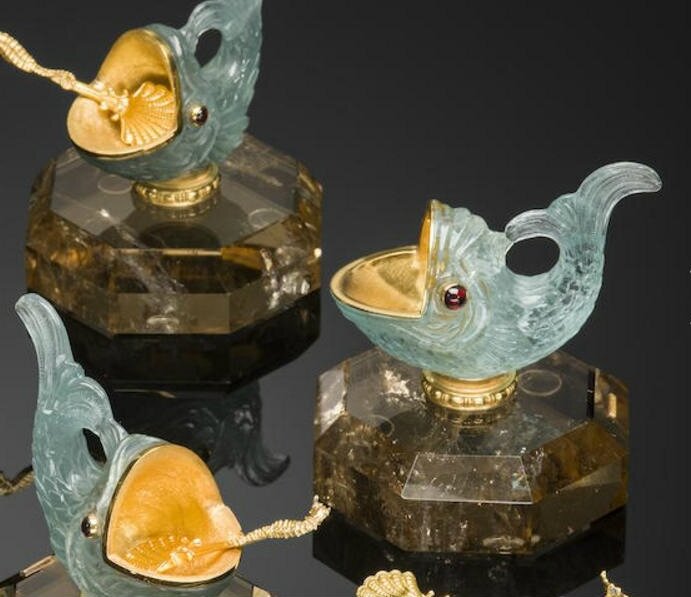World's Largest Meteorite Carving Offered At Bonhams Auction
LOS ANGELES – The first skull to be carved out of one of the rarest materials on Earth will be offered in Bonhams' Lapidary Works of Art, Gemstones and Minerals auction on November 24 at Bonhams, Los Angeles.
A life-size model of a male skull and the world's largest known meteorite carving, artist Lee Downey acid-etched the carving to uncover the Gibeon meteorite's singular, lattice-like "Widmanstätten" pattern. Downey is known for selecting exotic materials with which to work.
"By sculpting the skull's undulating curves, and because each crystal reacted uniquely to the acid treatment, Downey brought out features never seen before in Gibeon," said Claudia Florian, Bonhams Co-Consulting Director of Lapidary Works of Art, Specimen Gemstones and Minerals.
"Beneath the triangular geometry on the skull's surface, 'thumbprints' of crystallisation, graphite spots and 'light threads' refracted by the iron nickel layers can be seen for the first time," she said. "It's out of this world."
Downey chose Gibeon meteorite because it "best embodies the 'mystery'" of the human skull. Its track through time and space make it "the architecturally 'perfect' form for the brain vessel," he said. Painstaking measurements were taken from an actual skull of a male to ensure realism and accuracy.
Named "Yorick", the carving draws reference to the dead court jester whose skull triggers Hamlet's monologue on mortality in Act 5, Scene I of William Shakespeare's play. Historically, skulls have been associated with death, after-life, rebellion and carpe diem.
"Yorick" is also remarkable because it is flawless; polished meteorite typically features pits and cracks. The tridymite on the skull's forehead – a silica polymorph and an exceptionally rare component in IVA irons – was a part of the Gibeon rock; its location was completely fortuitous.
ABOUT GIBEON
• Gibeon is iron-based and one of the rarest forms of meteorite.
• It originated billions of years ago from an unstable planet that existed briefly between Jupiter and Mars.
• When the planet broke apart, a section of its core travelled through space for four billion years.
• Only the vacuum of space – which provides no surrounding molecules through which heat can be conducted away from the meteorite – allows the prolonged period of intense heat necessary for the alloys of iron meteorites to crystallize.
• During its journey, the meteorite's alloys crystallised to form an octahedral crystalline structure that cannot be recreated on earth.
• When it met the earth's atmosphere, about 1000 years ago, it exploded over the Kalahari Desert.
• The iron rain formed a meteorite field in Great Namaqualand, Namibia, which was first discovered by the local Nama people.
• A 48,000 gramme block was cut out of the heart of a complete, 280 kg iron meteorite, which Downey then painstakingly carved down to the carving's 21,070 grammes.
• Radiometric dating estimates the age of crystallisation of Gibeon's metal at approximately 4 billion years.
ABOUT LEE DOWNEY
Downey is an American artist who lives and works with a family of master carvers in Bali. He has fashioned skulls from woolly mammoth ivory, bowling balls and jet, but Gibeon is by far his most ambitious decision.
Highlights of "Lapidary Works of Art, Gemstones and Minerals" sale includes:
Carved in Russia by a contemporary master of Lapidary Works of Art, the original rough aquamarine crystal from Africa from which it was carved weighed over 30,000 carats. This is a lapidary carving which rivals those created in Idar-Obertein, Germany. A dramatic composition depicting Poseidon, the Sea God, in combat with a giant octopus, his silver knife poised to slay the creature. Raised on a rock crystal base, with a matte, frosted finish. Set with mother-of-pearl eyes. Weighing approximately 16,459.5 carats (3291.9 grams). Measures 11 x 6 x 7 in
Very Fine 8.39 carats Alexandrite, Sri Lanka. Estimate US$ 100,000 - 120,000 (€93,000 - 110,000). Photo: Bonhams.
Named for Tsar Alexander II, this rare and beautiful gem, of top quality, is infrequently used in modern jewelry. In antique Russian jewelry you may come across it with a little luck, since Russian master jewelers loved this stone. Tiffany's master gemologist George Frederick Kunz (1856-1932) was also fascinated by alexandrite, and the jeweler's firm produced some beautiful rings and platinum ensembles at the turn of the last century. Smaller alexandrites were occasionally also used in Victorian jewelry from England.
This classic stone, faceted as a square cushion-shape, displays all the most desirable characteristics which alexandrites should have: a fine reddish view, alternating to a deep, rich green, with a strong degree of color change between the two hues. Weighing approximately 8.39 carats and measuring 11.63 x 11.67 x 8.11mm
Accompanied by an American Gemological Laboratory report no. CS54809 dated October 21, 2014 stating that the natural Chrysoberyl variety Alexandrite stone Originates from Sri Lanka has a strong degree of color change (70 to 80%) and that the quality of color change is very good and that there is no evidence of enhancements or treatments present.
Blue Cap Tourmaline Crystal, Tourmaline Queen Mine, Pala District, San Diego County, California. Estimate US$ 55,000 - 75,000 (€51,000 - 70,000). Photo: Bonhams.
The Tourmaline Queen mine is well noted for its production of beautiful blue and pink tourmaline crystals. Most desirable to collectors are the pink to fuchsia color crystals with intense blue terminated ends. Several finds of this material were made in the 1970's. Extensive mining with underground tunnels has been done at the site with a limited amount of actual blue cap tourmaline crystals found. This crystal was produced in the 1970's by Pala International while they were working the mine. It has been held in a private collection since that time.
Distinguished by a very deep, sapphire-like blue color at the termination with deep pink color beneath it displays very good color and luster for a blue cap tourmaline of this size. A fine "side-car" crystal terminates half way up the side of the main crystal enhancing its aesthetics. The finest known examples have been considered the "crown jewels" at the Smithsonian Institution and the Houston Natural History Museum along with a small number of other collections, both public and private. Their extreme rarity and spectacular coloration have made them among the most coveted and desirable of all mineral specimens. Measuring 91mm x 40mm x 36mm. Weight: 256.7 grams
Citrine Quartz Intaglio Plaque "Jaguar Woman" By Andreas von Zadora-Gerlof, Circa 1991. Estimate US$ 45,000 - 55,000 (€42,000 - 51,000). Photo: Bonhams.
Carved from a single block of water-clear citrine quartz, this is a detailed and masterful depiction of a phantasmagoric nude female figure surrounded by plumage with the head of a bird and a jaguar as her attributes. Weight of quartz approximately 40 lbs. Weight of base approximately 100 pounds. Measuring 20 x 14 x 3/4in
Raised on a custom-made stand of silver-plated bronze with black patina inserts fabricated by Texas artist King Gremillion of Lloyd & Paxton.
Andreas von Zadora-Gerlof
Canadian-born artist Baron Andreas von Zadora-Gerlof, is a master of the stone carving art called Glyptography. Known simply as Zadora, the Baron is famous among an elite circle for creating naturalistic animal carvings and timepieces. His career in Decorative Arts has paralleled those of the historic ateliers of Johan Melchior Dinglinger, Benvenuto Cellini and Peter Carl Fabergé rather than any modern day jeweler. His private relationships with his patrons throughout the world make him a unique contributor to contemporary art history, undoubtedly influential, although rarely in public view.
The first American exhibition of the artist's work was presented at the Forbes Magazine Galleries in New York in 1992 and his works have also been exhibited at the Park Avenue Armory for the benefit of the Wildlife Conservation.
Set of Four Carved Aquamarine, Citrine and High-Karat Gold Salt Cellars with Spoons By Andreas Zadora-Gerlof, circa 1995. Estimate US$ 45,000 - 55,000 (€42,000 - 51,000). Photo: Bonhams.
Of Rococo influence, the present set of four salt cellars is extraordinary in its execution. Carved in the form of dolphins utilizing gem-grade aquamarine, each is adorned with a substantial amount of 18K gold to the open mouths. The eyes are formed of cabochon garnets, rimmed in 18K gold, while the dolphins rest upon a collar of gold. Each rests upon an octagonal natural citrine base of high transparency, with applied 18K gold plaque stamped Zadora. Accompanied by four 18K yellow gold spoons decorated with scallop shell and sea horse motifs. Signed Zadora and stampled 18K. Each measures 3 1/2 x 3 1/2 x 3 1/2 in (8)
Auction preview hours (open to the public): November 21 from 12 p.m. – 5 p.m. PST; November 22 from 12 p.m. – 5 p.m.; and November 23 from 12 p.m. – 5 p.m.

/https%3A%2F%2Fprofilepics.canalblog.com%2Fprofilepics%2F1%2F0%2F100183.jpg)
/https%3A%2F%2Fstorage.canalblog.com%2F03%2F02%2F119589%2F96711876_o.jpg)
/https%3A%2F%2Fstorage.canalblog.com%2F11%2F31%2F119589%2F94773502_o.jpg)
/https%3A%2F%2Fstorage.canalblog.com%2F20%2F83%2F119589%2F94772815_o.jpg)
/https%3A%2F%2Fstorage.canalblog.com%2F26%2F72%2F119589%2F75604929_o.jpg)
/https%3A%2F%2Fstorage.canalblog.com%2F59%2F60%2F119589%2F26458628_o.jpg)












/http%3A%2F%2Fstorage.canalblog.com%2F79%2F75%2F119589%2F111183724_o.jpg)
/http%3A%2F%2Fstorage.canalblog.com%2F72%2F15%2F119589%2F110763089_o.jpg)
/http%3A%2F%2Fstorage.canalblog.com%2F18%2F99%2F119589%2F126898623_o.jpg)
/http%3A%2F%2Fstorage.canalblog.com%2F06%2F86%2F119589%2F117723483_o.jpg)